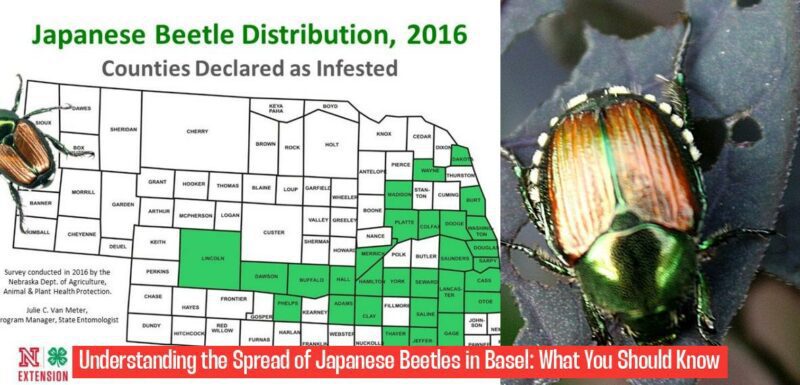Pests Japanese Beetle Continues to Spread in Basel: What You Need to Know
The Japanese beetle, an invasive species known for its voracious appetite and destructive tendencies, has continued its relentless spread in Basel-Stadt. The city’s gardening department has taken decisive action, expanding the infestation zone to encompass a significant portion of the canton’s territory. This move, announced on Friday by the Basel Department of Construction and Transport, reflects the growing concern over the beetle’s impact on the region’s ecosystem and agricultural practices.
The new infestation zone, covering a good third of the canton, includes Grossbasel Ost, parts of Kleinbasel, and the municipalities of Riehen BS and Birsfelden BL. This expansion highlights the beetle’s ability to quickly colonize new areas, posing a serious threat to local biodiversity and agricultural yields.
Strict Guidelines to Combat the Invasive Species
To curb the spread of these destructive pests, the authorities have implemented strict guidelines within the designated zone. Until the end of September, watering lawns is strictly prohibited in these areas. This measure aims to reduce the attractiveness of the soil for egg-laying, as female Japanese beetles prefer moist, grassy environments. However, gardeners can still water their plants in pots and beds, as long as they do not contain any grass.
The movement of green material, compost, and soil is also subject to strict regulations. These materials can only leave the designated zone under specific conditions, ensuring that the beetles do not hitch a ride to new locations. This strict control over the movement of potentially infested materials is crucial to prevent the insect’s further spread.
Cooperation for Effective Pest Control
The measures implemented in Basel-Stadt are a collaborative effort between the city gardening department, the federal authorities, and the neighboring canton of Baselland. This collaboration underscores the importance of coordinated action to combat invasive species, as their impact transcends administrative boundaries.
The Japanese beetle’s presence in Basel-Stadt poses a significant threat to the region’s ecological balance. The insect’s voracious appetite for plants, particularly grasses and flowers, can decimate gardens, parks, and agricultural fields. This can lead to substantial economic losses for farmers and gardeners, as well as an aesthetic decline in public spaces.
Public Participation in Combating the Beetle
The Basel gardening department is actively encouraging public participation in the fight against the Japanese beetle. They urge residents to report any beetle sightings, no matter how small, to help track the insect’s movements and inform control measures.
The department provides clear instructions on how to handle the captured beetles. Residents are advised to place any captured beetles in a tightly closed jar or food can and then freeze them overnight, even if they appear to be dead. This method ensures that the beetles are effectively eliminated, preventing them from laying eggs and exacerbating the infestation.
Understanding the Japanese Beetle: A Threat to Biodiversity
The Japanese beetle, scientifically known as Popillia japonica, is a highly adaptable invasive species that has successfully established itself in various parts of the world. Native to Japan, the beetle arrived in North America in 1916 and has since spread across the continent, causing significant ecological and economic damage.
The beetle’s invasive nature is a cause for global concern. Its ability to quickly colonize new areas and its destructive feeding habits make it a serious threat to agricultural production, biodiversity, and ecological balance.
The Japanese Beetle’s Life Cycle: Understanding Its Spread
The Japanese beetle’s lifecycle plays a crucial role in its rapid spread. Adult beetles emerge from the soil in late spring or early summer, feeding on leaves, flowers, and fruits. They mate and lay eggs in the soil, typically in moist, grassy areas.
After hatching, the larvae feed on roots, causing damage to lawns and other plants. This underground stage lasts for several months, before the larvae pupate and eventually emerge as adults, completing the lifecycle. This cyclical process allows for rapid population growth, further increasing the beetle’s invasive potential.
The Impact of Japanese Beetles: A Threat to Agricultural Production
The Japanese beetle’s feeding habits pose a significant threat to agricultural production, especially in areas where it has established itself as an invasive species. The insect’s voracious appetite for plants can decimate entire crops, leading to substantial economic losses for farmers.
The beetle’s impact is particularly severe on fruit trees, vegetables, and ornamental plants. Its feeding habits can cause significant damage to leaves, flowers, and fruits, reducing crop yield and quality. This can have a profound impact on agricultural markets, potentially leading to higher prices and reduced availability of certain produce.
Controlling the Spread of Japanese Beetles: A Multifaceted Approach
Controlling the spread of Japanese beetles requires a multifaceted approach that involves a combination of prevention, early detection, and control measures. This approach aims to minimize the beetle’s impact on the environment and agricultural production.
Prevention: A Proactive Approach to Limit Spread
The most effective way to control the spread of invasive species is through prevention. This involves implementing measures to prevent their introduction and establishment in new areas.
In the case of the Japanese beetle, this involves inspecting imported plant materials and soil for the presence of beetles or their eggs. This proactive approach can significantly reduce the risk of inadvertently introducing the insect to new areas.
Early Detection: A Crucial Step in Controlling Spread
Early detection is crucial for preventing the establishment of invasive species. This involves monitoring for the presence of the invasive species and implementing control measures as soon as possible.
In the case of the Japanese beetle, this involves conducting regular inspections of lawns, gardens, and agricultural fields for signs of the insect. This can include visually inspecting plants for damage and setting traps to capture and monitor beetle populations.
Control Measures: A Range of Options to Manage Spread
Once an invasive species has established itself, various control measures can be employed to manage its population and minimize its impact. These measures can include chemical pesticides, biological control agents, and cultural practices.
In the case of the Japanese beetle, chemical pesticides can be used to kill adult beetles and larvae. However, the use of pesticides should be carefully considered, as they can have unintended consequences for other organisms and the environment.
Biological control agents, such as parasites and predators that are specific to the Japanese beetle, can also be used to manage the insect’s population. This approach aims to reduce the beetle’s numbers without resorting to chemical pesticides.
Cultural practices, such as handpicking beetles, can also be used to control the insect’s population. This approach is particularly effective in small gardens and residential areas.
The Importance of Public Awareness and Action
The success of any invasive species control program relies heavily on public awareness and participation. Educating the public about the risks posed by invasive species and encouraging them to take action to prevent their spread is essential.
This includes encouraging residents to report sightings of invasive species, promoting responsible gardening practices, and supporting initiatives aimed at controlling their spread. By working together, we can limit the impact of invasive species and protect our ecosystems and agricultural production.
The Japanese beetle’s continued spread in Basel-Stadt highlights the importance of ongoing vigilance and collaborative efforts to manage invasive species. By understanding the insect’s life cycle, its impact, and effective control measures, we can mitigate its threat and protect our environment from its destructive effects.
What is the current situation with the Japanese beetle in Basel?
The Japanese beetle, known for its destructive tendencies, continues to spread in Basel-Stadt, with the infestation zone expanding to cover a significant portion of the canton’s territory.
More updates: Embarking on a Treasure Hunt: Unleashing Nami’s Epic Cosplay Journey
What measures have been taken to combat the spread of the Japanese beetle in Basel?
Strict guidelines have been implemented within the designated infestation zone, including a prohibition on watering lawns until the end of September to deter egg-laying. Movement of green material, compost, and soil is also strictly regulated to prevent further spread.
Who is involved in the efforts to control the Japanese beetle in Basel?
The city gardening department, federal authorities, and the neighboring canton of Baselland are collaborating to combat the invasive species, highlighting the importance of coordinated action in pest control.
What are the potential consequences of the Japanese beetle infestation in Basel?
The Japanese beetle’s presence poses a significant threat to the region’s ecological balance, with its appetite for plants leading to potential economic losses for farmers and gardeners, as well as impacting gardens, parks, and agricultural fields.



